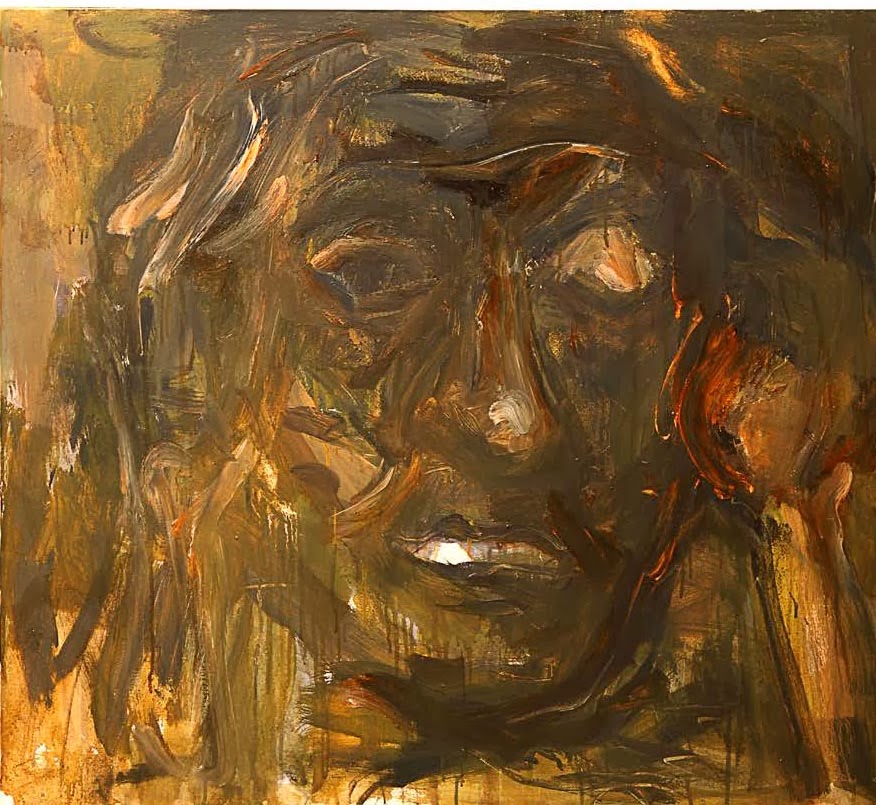Einstein once said that the most incredible thing about
the universe is that it is credible at all. There is chaos as
well as order in it and after failing to find the Holy Grail of
Science in his “Grand Unified Theory" Einstein took
comfort in the peace and joy he found in the pursuit of
art and music. It is a sad irony of our times that a sight
impaired artist should embark on a guest to become the
new visionary of the cosmic harmony that eluded
Einstein himself. The art of painting can reflect reality like
a mirror or distort it like a prism and it is but a magic
alchemy of forms expressed in colour and texture in the
manner of a shaman and sorcerer as Degas confessed.
To give it an attribute of divine revelation is to rob the
glory of creation from the creator himself.
 |
| (Tuka Jadhav his studio :2014) |
Tuka Jadhav's story is as tragic as it is thought
provoking. His rise from humble origins to win the
Bendre-Husain Award is an inspiration to others. His
catastrophic loss of vision an eclipse at the zenith of his
career. His attempts at a renaissance are exemplary and
grandiose. We are all moved by the divine beauty of
creation reflected in nature. A writer and poet try to
express it in words, a musician by melody and a painter
with colour. "Synergism” is the coming together ef such
creative energies to bring about peace and harmony.
The mood is created by the abstract "Buddha"
installation using a bicycle wheel, seat and screw. The
centre-piece of the show is a gigantic 110 x 200" work
called "Cosmic Harmony". It evokes the timeless and
eternal influence of the Sun and the Moon to make
nature blossom on earth. Like the Yin and Yang of
existence the artist's handprint above the red-black sun
expresses the commingling of matter and spirit.
A series of six river paintings pay homage to the water
element as the source and sustenance of the stream of
life. This aspect of “Pravaah" the eternal ebb and flew ef
thoughts, moods and feelings finds expression in
myriad forms and colour schemes in Tuka's work. Like
words and rhyme to a poet and melody and rhythm to a
musician they are an integral part of his an of
"Synergism". The two evocative works in swirling red,
white end green celled "Flowing Ganges" end "Triveni
Sangam" capture this essence end spirit. They were
made on the spot et Assi Ghat end Rudra Prayag end
inspired by their sacred piety. “Empty River” end
"Niranjani" have green traces of haunting memories of a
lost Iushness of his rustic youth. The massive 11O x 110"
work "Tarang" is full of a buoyant and rippling spirit end
recalls Tuka's eloquent verse in "Brush Blossoms". The
"Song of the Waghori” gives e musical expression in
colour to being free as a bird of paradise.
"Bhoomi Sparsha" in ethereal blue and white is e flight of
fancy celebrating the meeting of the heavenly and
earthly realms, "Prayer" shows e worshipful figure in
William de Kooning's style, "Sonography" and "Bicycle"
explore the formal aspects further, "Godhra Mother"
and "26/11 War" are stark reminders of the terrors of our
troubled times, the kite-shaped works "Heart & Soul"
and "For Neal Armstrong" are soaring tributes to friend
Shiveji Kale and Neel Armstrong the first men on the
moon. The serene “Ahimsa" and "Life Fundamentals"
with the embedded "Aum" of creation.
 |
| ( some of rare works by Tuka Jadhav date are not available ) |
Complete the set with the vertical panel "Global Peace"
which brings us beck to the show's sombre theme.
Tuka's vision is grandiose. Whet it may Iack in
exactitude he tries to make up with the exuberance end
extravagance of his irrepressible spirit. Like e spark in
the dark it rekindles e forlorn hope for a way to find some
"Cosmic Harmony" in the darkness and despair of our
times as we celebrate Diwali Eid end Christmas as the
festivals of light.
Like e Spark in the Dark
lonely firefly left his mark
In the darkness of the night
Like him I sought the Light!
lonely firefly left his mark
In the darkness of the night
Like him I sought the Light!


















